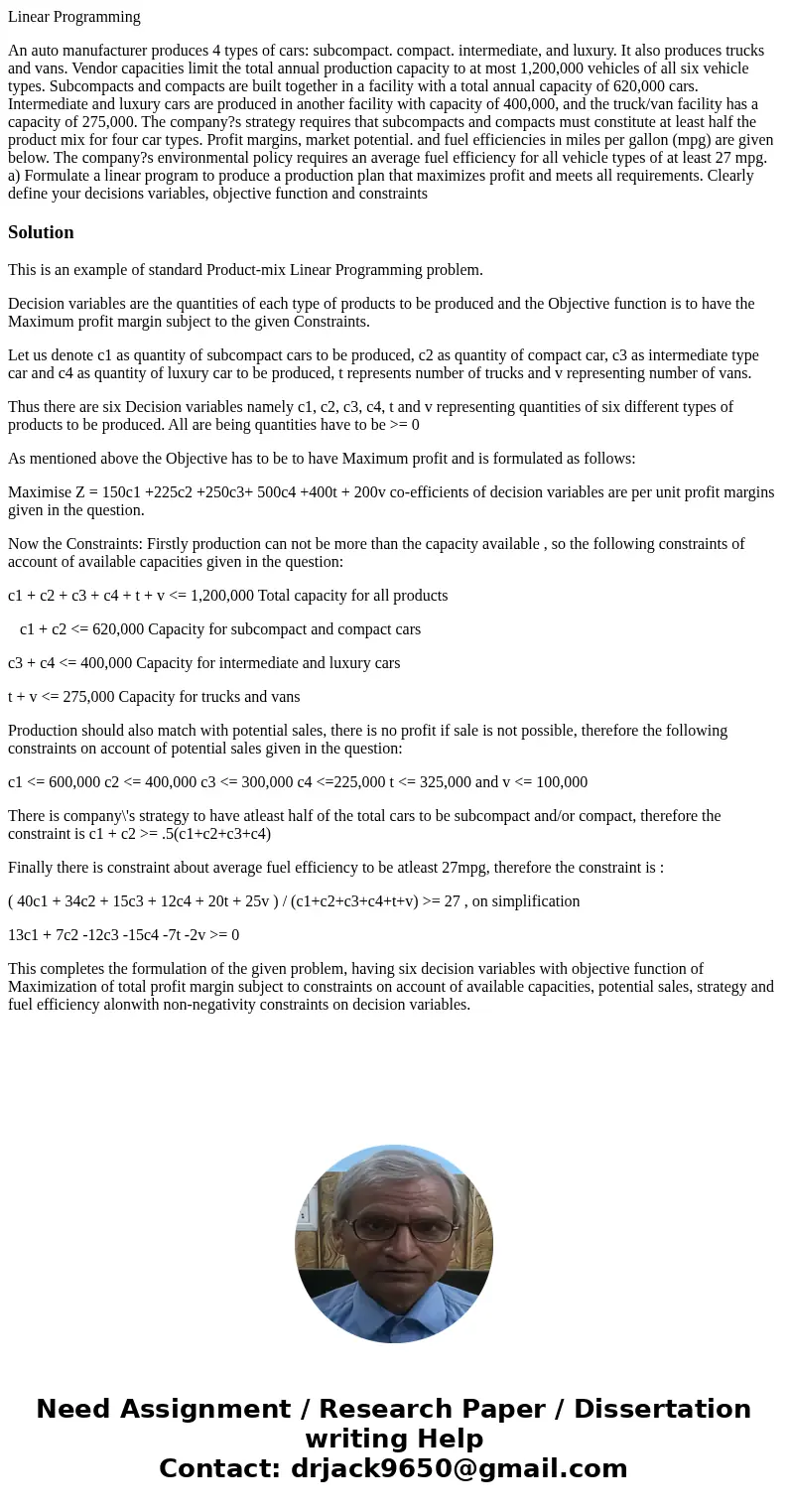Linear Programming An auto manufacturer produces 4 types of
Linear Programming
An auto manufacturer produces 4 types of cars: subcompact. compact. intermediate, and luxury. It also produces trucks and vans. Vendor capacities limit the total annual production capacity to at most 1,200,000 vehicles of all six vehicle types. Subcompacts and compacts are built together in a facility with a total annual capacity of 620,000 cars. Intermediate and luxury cars are produced in another facility with capacity of 400,000, and the truck/van facility has a capacity of 275,000. The company?s strategy requires that subcompacts and compacts must constitute at least half the product mix for four car types. Profit margins, market potential. and fuel efficiencies in miles per gallon (mpg) are given below. The company?s environmental policy requires an average fuel efficiency for all vehicle types of at least 27 mpg. a) Formulate a linear program to produce a production plan that maximizes profit and meets all requirements. Clearly define your decisions variables, objective function and constraintsSolution
This is an example of standard Product-mix Linear Programming problem.
Decision variables are the quantities of each type of products to be produced and the Objective function is to have the Maximum profit margin subject to the given Constraints.
Let us denote c1 as quantity of subcompact cars to be produced, c2 as quantity of compact car, c3 as intermediate type car and c4 as quantity of luxury car to be produced, t represents number of trucks and v representing number of vans.
Thus there are six Decision variables namely c1, c2, c3, c4, t and v representing quantities of six different types of products to be produced. All are being quantities have to be >= 0
As mentioned above the Objective has to be to have Maximum profit and is formulated as follows:
Maximise Z = 150c1 +225c2 +250c3+ 500c4 +400t + 200v co-efficients of decision variables are per unit profit margins given in the question.
Now the Constraints: Firstly production can not be more than the capacity available , so the following constraints of account of available capacities given in the question:
c1 + c2 + c3 + c4 + t + v <= 1,200,000 Total capacity for all products
c1 + c2 <= 620,000 Capacity for subcompact and compact cars
c3 + c4 <= 400,000 Capacity for intermediate and luxury cars
t + v <= 275,000 Capacity for trucks and vans
Production should also match with potential sales, there is no profit if sale is not possible, therefore the following constraints on account of potential sales given in the question:
c1 <= 600,000 c2 <= 400,000 c3 <= 300,000 c4 <=225,000 t <= 325,000 and v <= 100,000
There is company\'s strategy to have atleast half of the total cars to be subcompact and/or compact, therefore the constraint is c1 + c2 >= .5(c1+c2+c3+c4)
Finally there is constraint about average fuel efficiency to be atleast 27mpg, therefore the constraint is :
( 40c1 + 34c2 + 15c3 + 12c4 + 20t + 25v ) / (c1+c2+c3+c4+t+v) >= 27 , on simplification
13c1 + 7c2 -12c3 -15c4 -7t -2v >= 0
This completes the formulation of the given problem, having six decision variables with objective function of Maximization of total profit margin subject to constraints on account of available capacities, potential sales, strategy and fuel efficiency alonwith non-negativity constraints on decision variables.

 Homework Sourse
Homework Sourse